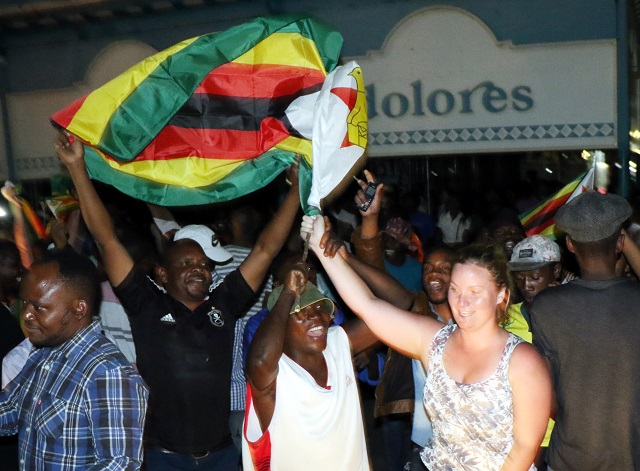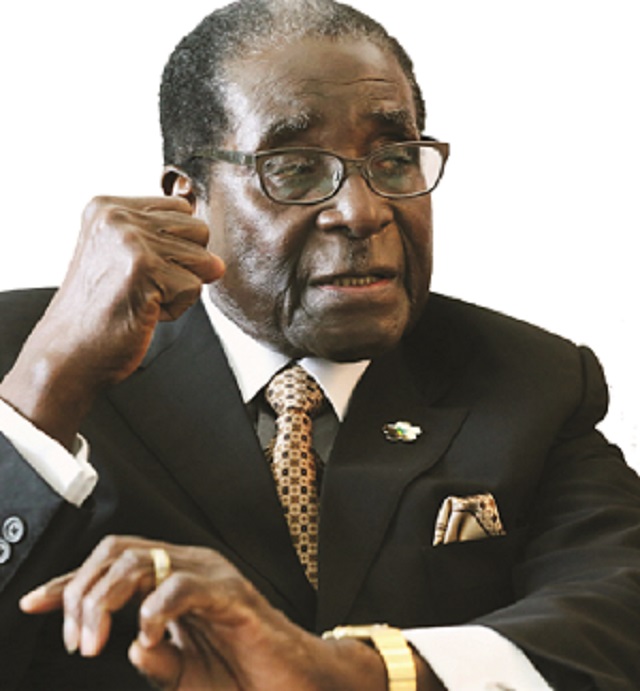When the Zimbabwe flag evoked a true patriotic spirit


Bulawayo joins the nation in celebrating former President Robert Mugabe’s resignation on Tuesday last week
Runyararo Muzavazi and Tatenda Charamba
This past week the Zimbabwe flag stirred up a sense of pride and acted as a rallying point for the whole nation
SHOUTING, cheering, waving flags, blowing horns and shooting fireworks, tens of thousands of people across the entire country were ecstatic when former president Robert Mugabe stepped down on Tuesday last week.
Though many acknowledged that former President Cde Mugabe was an unquestionable national hero, millions of jubilant Zimbabweans welcomed the Zimbabwe Defence Forces intervention to restore stability and triumphant return of President Mnangagwa home, waving flags and chanting “Kutonga Kwaro,” as they basked in the nation’s prospects for economic revival.
In all cities, towns, growth points and everywhere, hundreds of thousands of revellers sang and danced waving the Zimbabwean flag, a potent symbol of independence and freedom.
The young and old people alike were decked out in Zimbabwe flag colours, many with their faces painted green, yellow, red and black and with wigs and bandanas in the national colours.
Many had started drinking beer as soon as word spread about former President Mugabe’s resignation.
The flag-waving spectacle was given an air of ceremonial grandeur. The patriotic spirit reached a high pitch.
“This is a once-in-a-lifetime experience, it’s something to remember,” said Tendai Sakala waving the Zimbabwean flag. “I’m excited about Mugabe’s exit and the coming in of Mnangagwa. It was long overdue and we wanted change of leadership.”
Wild scenes broke out and scores of people jumped, screamed, waved and held up the Zimbabwe flag.
“I am really excited to welcome Mnangagwa as the new leader during my lifetime,” said Farai Mutema, resplendent in the Zimbabwean flag.
“I never hoped that one day I would witness the coming in of a new leader.”
In all this, it was the Zimbabwean flag that stood out helping, the young, a demographic feeling the pain of the country’s difficult economic circumstances.
The flag helped Zimbabweans take greater pride in their nationality. Harsh economic conditions that had prevailed in the last two decades had made them uncomfortable about displaying such feelings.
Radio and television channels blanketed the airwaves with coverage of the resignation of Cde Mugabe while newspapers dedicated whole editions to his departure. At the same time, the entrance of President Mnangagwa sparked wild celebrations and put Zimbabwe firmly on the international limelight.
“Ngwena, Ngwena, Ngwena,” chanted Charles Mapuweyi holding a big poster of President Mnangagwa.
The new political era, evoked patriotic feelings and love for the Zimbabwean flag.
Business was brisk for vendors selling the Zimbabwe flags and Jah Prayzah’s popular Kutonga kwaro album.
“I have never sold national flags like this,” said Takudzwa Nemakore, a street vendor in the capital. “Demand for them was too much. I am so proud and ecstatic about the new political changes.”
He said on the day Cde Mugabe resigned, he sold 124 flags.
Flags were being sold for 50 cents (smallest), $1 for a medium sized one and up to $5 for the bigger ones.
Another vendor, Lawrence Masimba (24) also said they got good business this whole week.
“I have a reason to wake up and come to work because the businees of selling flags is roaring. My sales were good this week,” he said.
Most vendors said business was good.
Many jubilant youths bought flags in huge numbers, a rare occurrence, for this demographic group which was fast losing hope about their future.
Most people rekindled their love affair with the Zimbabwe flag, something that saw many beaming with national pride.
The Zimbabwean flag has once more become a symbol of national unity and a rallying point for national pride and dignity.
“There has never been a better time for Zimbabweans to hold and wave their flag than now when we are witnessing a big change in our politics,” said Charles Mpanda, a city businessman.
“As I grew up the flag was held in high esteem but over the years the spirit of joy that came with the flag had died down. Now, it’s different, people have all of a sudden fallen in love with the Zimbabwe flag. It’s amazing and beautiful.
“It is surprising and exciting to see people freely waving the flag in the streets and some wearing custom-made Zimbabwe flag wrist bands as a way of showing their happiness towards the new era and love for the country.”
The waving of flags managed to bring people together despite their differences racially or politically.
During the march the flag literally preached the gospel of peace, humanity, togetherness and tranquillity.
Sylvester Kamonera (45) said he had every right to wave the flag despite his surprising lack of knowledge about the meaning of colours and symbols on it.
“I don’t quite know the meaning of the flag, but I am happy to lift the flag high,” he said smiling.
“The flag means Zimbabwe and it brings us together no matter our differences.”
The flag is not just merely for display, every element on the flag has a meaning.
The Zimbabwean flag, speaks symbolically about the country’s history, people and aspirations.
It has enabled the people to appreciate their past and to shape their destiny while at the same time using it as a nation’s identity.
This past week the Zimbabwe flag stirred up a sense of pride and acted as a rallying point for the whole nation.
For 37 years, unchanged, it is the longest and most enduring flag in the history of the country.
Before independence in 1980, settlers starting from Lieutenant Edward Tyndale-Biscoe of the Pioneer Column who hoisted the Union Jack in 1890 on the Kopje overlooking Fort Salisbury (now Harare), to the UDI Rhodesian era and the short-lived 1979 Zimbabwe-Rhodesia period, the country changed flags several times.
The shortest flag lifespan was the Zimbabwe- Rhodesia one which lasted for three months while the 1980 Zimbabwe flag boasts of some 37 years.
“To me this time, the Zimbabwe flag gave me a feeling which I could’nt even explain,” said Charlene Moyo, a university student. “The political changes happening in our country are unbelievable. It’s like a dream.”
Some, though, expressed cautious optimism.
“We may celebrate today, we may joyfully celebrate tonight, but when the sun comes up tomorrow, we are to shoulder the responsibilities for reforming the nation ourselves,” said a businessman.
“ED cannot do everything for us. We have to play our part.”










Comments